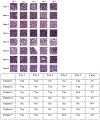Comprehensive Molecular and Pathologic Evaluation of Transitional Mesothelioma Assisted by Deep Learning Approach: A Multi-Institutional Study of the International Mesothelioma Panel from the MESOPATH Reference Center
- PMID: 32165206
- PMCID: PMC8864581
- DOI: 10.1016/j.jtho.2020.01.025
Comprehensive Molecular and Pathologic Evaluation of Transitional Mesothelioma Assisted by Deep Learning Approach: A Multi-Institutional Study of the International Mesothelioma Panel from the MESOPATH Reference Center
Abstract
Introduction: Histologic subtypes of malignant pleural mesothelioma are a major prognostic indicator and decision denominator for all therapeutic strategies. In an ambiguous case, a rare transitional mesothelioma (TM) pattern may be diagnosed by pathologists either as epithelioid mesothelioma (EM), biphasic mesothelioma (BM), or sarcomatoid mesothelioma (SM). This study aimed to better characterize the TM subtype from a histological, immunohistochemical, and molecular standpoint. Deep learning of pathologic slides was applied to this cohort.
Methods: A random selection of 49 representative digitalized sections from surgical biopsies of TM was reviewed by 16 panelists. We evaluated BAP1 expression and CDKN2A (p16) homozygous deletion. We conducted a comprehensive, integrated, transcriptomic analysis. An unsupervised deep learning algorithm was trained to classify tumors.
Results: The 16 panelists recorded 784 diagnoses on the 49 cases. Even though a Kappa value of 0.42 is moderate, the presence of a TM component was diagnosed in 51%. In 49% of the histological evaluation, the reviewers classified the lesion as EM in 53%, SM in 33%, or BM in 14%. Median survival was 6.7 months. Loss of BAP1 observed in 44% was less frequent in TM than in EM and BM. p16 homozygous deletion was higher in TM (73%), followed by BM (63%) and SM (46%). RNA sequencing unsupervised clustering analysis revealed that TM grouped together and were closer to SM than to EM. Deep learning analysis achieved 94% accuracy for TM identification.
Conclusion: These results revealed that the TM pattern should be classified as non-EM or at minimum as a subgroup of the SM type.
Keywords: Histology; Mesothelioma; Surgery; Systemic treatment.
Copyright © 2020. Published by Elsevier Inc.
Figures









Comment in
-
Transitional Mesothelioma and Artificial Intelligence: Do We Need One More Subtype? and Do We Need Computers to Identify Them?J Thorac Oncol. 2020 Jun;15(6):884-887. doi: 10.1016/j.jtho.2020.03.025. J Thorac Oncol. 2020. PMID: 32471562 No abstract available.
References
-
- Bray F, Ferlay J, Soerjomataram I, Siegel RL, Torre LA, Jemal A. Global cancer statistics 2018: GLOBOCAN estimates of incidence and mortality worldwide for 36 cancers in 185 countries. CA Cancer J Clin. 2018;68:394–424. - PubMed
-
- Opitz I, Friess M, Kestenholz P, et al. A new prognostic score supporting treatment allocation for multimodality therapy for malignant pleural mesothelioma: a review of 12 years’ experience. J Thorac Oncol. 2015;10:1634–1641. - PubMed
-
- Hasegawa S, Okada M, Tanaka F, et al. Trimodality strategy for treating malignant pleural mesothelioma: results of feasibility study of induction pemetrexed plus cisplatin followed by extrapleural pneumonectomy and postoperative hemithoracic radiation (Japan Mesothelioma Interest Group 0601 Trial). Int J Clin Oncol. 2016;21:523–530. - PMC - PubMed
-
- Tsao AS, Lindwasser OW, Adjei AA, et al. Current and future management of malignant mesothelioma: a consensus report from the National Cancer Institute Thoracic Malignancy Steering Committee, International Association for the Study of Lung Cancer, and Mesothelioma Applied Research Foundation. J Thorac Oncol. 2018;13:1655–1667. - PubMed
Publication types
MeSH terms
Substances
Grants and funding
LinkOut - more resources
Full Text Sources
Medical
Miscellaneous

